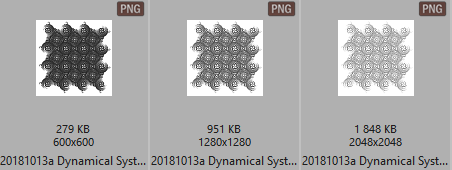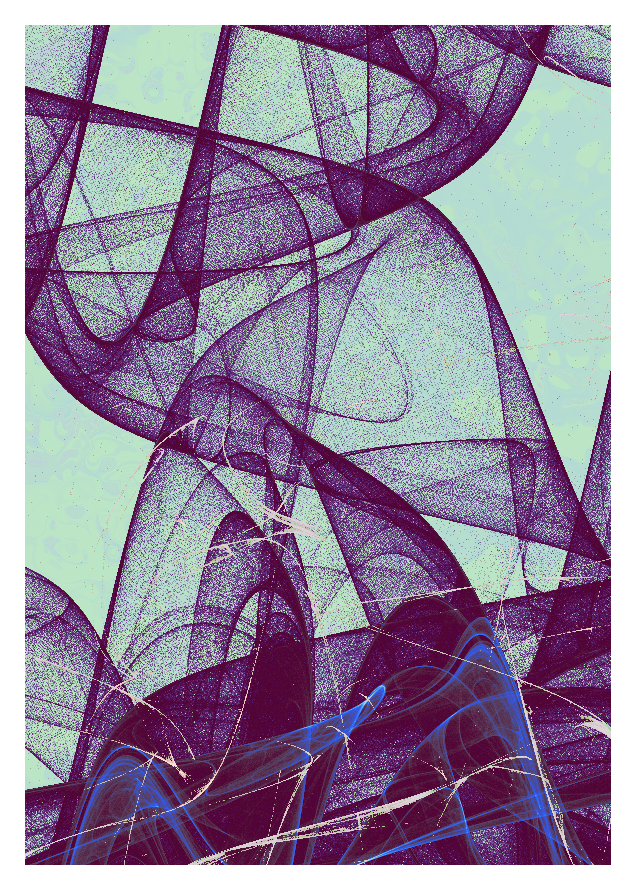Here are some belated examples and a few tips...
The first example is a good starting point for exploration. Note that the Drawing Method on the Formula tab is set to One-pass Linear and that Repeat Gradient on the Outside tab is un-checked. The gradient is greyscale. You can try other types of gradients but the results will vary.
20181013aDynamicalSystemsExample
fractal:
title="20181013a Dynamical Systems Example #1" width=800 height=800
layers=1 credits="Mark Townsend;10/13/2018"
layer:
caption="Background" opacity=100 method=multipass
mapping:
center=0/0 magn=0.15
formula:
maxiter=100 filename="mt.ufm" entry="mt-pixel" p_inside=no
inside:
transfer=none
outside:
transfer=linear repeat=no filename="mt5.ucl"
entry="mt-dynamical-systems-r" p_sample_mode=Grid
p_sample_center=0/0 p_sample_width=20 p_h=0.1 p_max_iterations=50
p_resolution=500 p_circular_mask=no p_dual_functions=no
p_XFuncParam="mt.ulb:MT_VineFunction" p_XFuncParam.flavor=-1
p_XFuncParam.a=7 p_XFuncParam.b=2.0
p_YFuncParam="mt.ulb:MT_DynamicalFunction" p_add_noise=no
p_noise_amount=1 p_noise_scale=1 p_noise_texture.v_generic=100
p_noise_texture.v_coloring=100
p_noise_texture.v_gradientcoloring=100
p_noise_texture.p_texture="mt.ulb:MT_PerlinNoiseTexture"
p_noise_texture.p_texture.v_generic=100
p_noise_texture.p_texture.v_trapshape=101
p_noise_texture.p_texture.octaves=7
p_noise_texture.p_texture.persistence=0.5
f_noise_texture.p_texture.fn1=ident
p_noise_texture.p_texture.seed=1234567 p_add_transform=no
p_transform="common.ulb:UserTransform" p_transform.v_generic=100
p_transform.v_transform=100 p_transform.v_usertransform=100
p_seed=1234567
gradient:
comments="Use with Lighting coloring algorithm." smooth=yes index=0
color=16777215 index=399 color=0 index=399 color=0
opacity:
smooth=no index=0 opacity=255
}
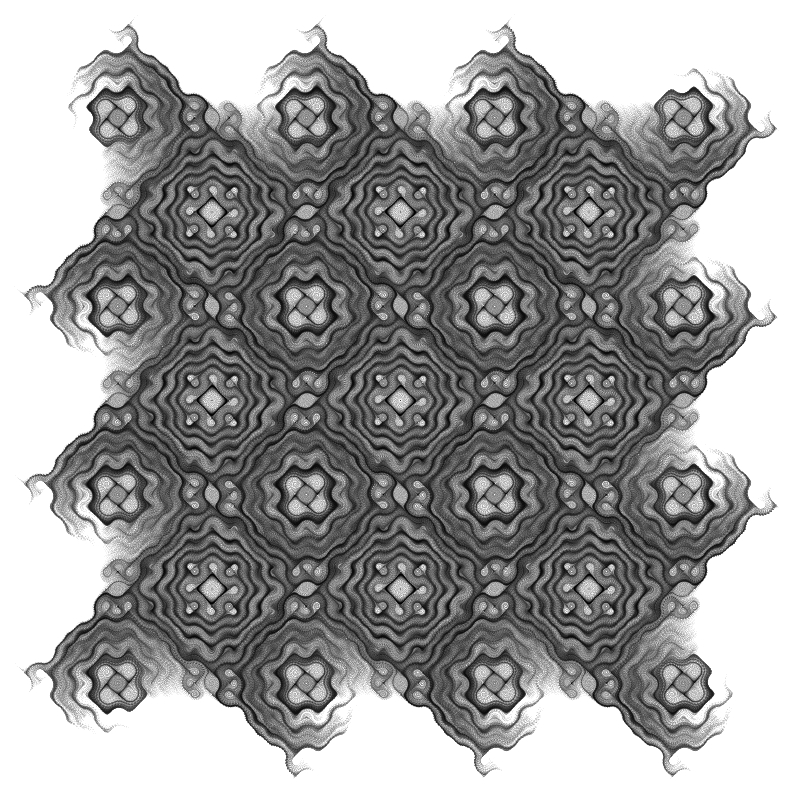
For then next one I changed the Vine parameters and zoomed into one of the patterns. Because I'm zooming in I can decrease the Width parameter because I want to concentrate the calculation on the visible area. I copied Center from the Location tab and pasted it into the Center parameter of the coloring. For this one I've changed the Sample Mode to "Random". I've included an image of the Vine fractal formula in the same location so you can see the differences.
20181013bDynamicalSystemsExample
fractal:
title="20181013b Dynamical Systems Example #2" width=800 height=600
layers=1 credits="Mark Townsend;10/13/2018"
layer:
caption="Background" opacity=100 method=multipass
mapping:
center=-3.1333333335/-3.09999999985 magn=0.6
formula:
maxiter=100 filename="mt.ufm" entry="mt-pixel" p_inside=no
inside:
transfer=none
outside:
transfer=linear repeat=no filename="mt5.ucl"
entry="mt-dynamical-systems-r" p_sample_mode=Random
p_sample_center=-3.1333333335/-3.09999999985 p_sample_width=8
p_h=0.1 p_max_iterations=20 p_resolution=1000 p_circular_mask=no
p_dual_functions=no p_XFuncParam="mt.ulb:MT_VineFunction"
p_XFuncParam.flavor=0 p_XFuncParam.a=7 p_XFuncParam.b=2.0
p_YFuncParam="mt.ulb:MT_DynamicalFunction" p_add_noise=no
p_noise_amount=1 p_noise_scale=1 p_noise_texture.v_generic=100
p_noise_texture.v_coloring=100
p_noise_texture.v_gradientcoloring=100
p_noise_texture.p_texture="mt.ulb:MT_PerlinNoiseTexture"
p_noise_texture.p_texture.v_generic=100
p_noise_texture.p_texture.v_trapshape=101
p_noise_texture.p_texture.octaves=7
p_noise_texture.p_texture.persistence=0.5
f_noise_texture.p_texture.fn1=ident
p_noise_texture.p_texture.seed=1234567 p_add_transform=no
p_transform="common.ulb:UserTransform" p_transform.v_generic=100
p_transform.v_transform=100 p_transform.v_usertransform=100
p_seed=1234567
gradient:
comments="Use with Lighting coloring algorithm." smooth=yes index=0
color=16777215 index=0 color=16777215 index=259 color=0 index=399
color=0 index=399 color=0
opacity:
smooth=no index=0 opacity=255
}
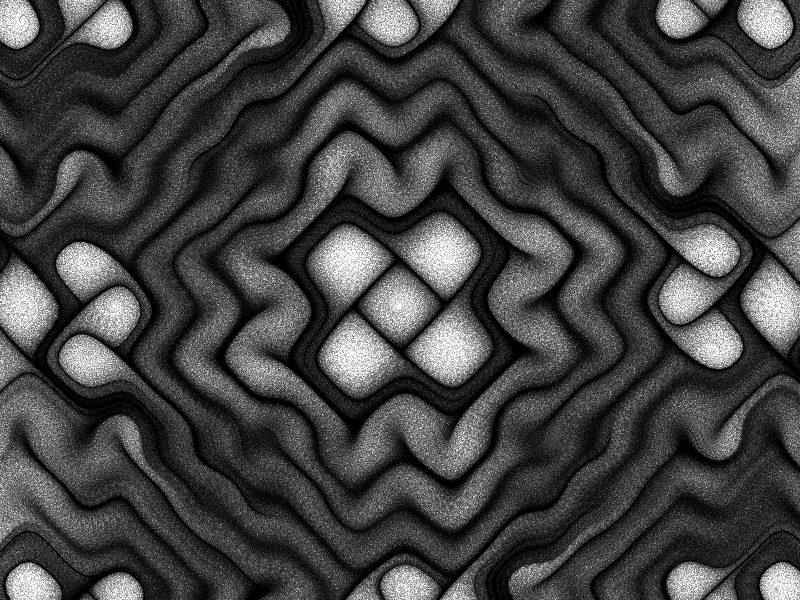
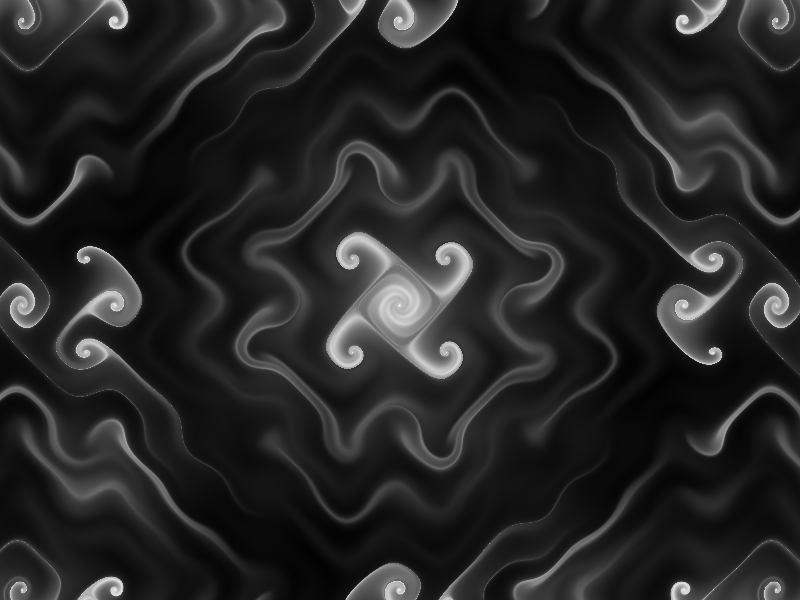
Next I add a Transform. I tend to go straight for my "Trap Shape" transform plug-in because it allows me to load my texture plug-ins and it has a Strength parameter. Notice that I've added a new control point to the gradient and dragged it to the left to darken the image. This one takes a bit longer to appear. That's a combination of the higher Resolution and the fact that the transform is calculated for every iteration.
20181013cDynamicalSystemsExample
fractal:
title="20181013c Dynamical Systems Example #3" width=800 height=800
layers=1 credits="Mark Townsend;10/13/2018"
layer:
caption="Background" opacity=100 method=multipass
mapping:
center=-2.1607881435/3.1891277375 magn=0.50420168 angle=44.2834
formula:
maxiter=100 filename="mt.ufm" entry="mt-pixel" p_inside=no
inside:
transfer=none
outside:
transfer=linear repeat=no filename="mt5.ucl"
entry="mt-dynamical-systems-r" p_sample_mode=Grid
p_sample_center=0/0 p_sample_width=10 p_h=0.1 p_max_iterations=50
p_resolution=1000 p_circular_mask=no p_dual_functions=no
p_XFuncParam="mt.ulb:MT_VineFunction" p_XFuncParam.flavor=-1
p_XFuncParam.a=7 p_XFuncParam.b=2.0
p_YFuncParam="mt.ulb:MT_DynamicalFunction" p_add_noise=no
p_noise_amount=1 p_noise_scale=1 p_noise_texture.v_generic=100
p_noise_texture.v_coloring=100
p_noise_texture.v_gradientcoloring=100
p_noise_texture.p_texture="mt.ulb:MT_PerlinNoiseTexture"
p_noise_texture.p_texture.v_generic=100
p_noise_texture.p_texture.v_trapshape=101
p_noise_texture.p_texture.octaves=7
p_noise_texture.p_texture.persistence=0.5
f_noise_texture.p_texture.fn1=ident
p_noise_texture.p_texture.seed=1234567 p_add_transform=yes
p_transform="mt.ulb:MT_TrapShapeTransform" p_transform.v_generic=100
p_transform.v_transform=100 p_transform.v_usertransform=100
p_transform.mode="Return Value" p_transform.strength=0.03
p_transform.p_trapshape="reb.ulb:REB_TrapShapeLissajous"
p_transform.p_trapshape.v_generic=100
p_transform.p_trapshape.v_trapshape=101
p_transform.p_trapshape.v_Lissajous=101
p_transform.p_trapshape.a=0.2 p_transform.p_trapshape.b=1
p_transform.p_trapshape.c=1 p_transform.p_trapshape.scale=1
p_transform.p_trapshape.partype="cabs(z)" p_seed=1234567
gradient:
comments="Use with Lighting coloring algorithm." smooth=yes index=0
color=16777215 index=146 color=0 index=399 color=0 index=399 color=0
opacity:
smooth=no index=0 opacity=255
}
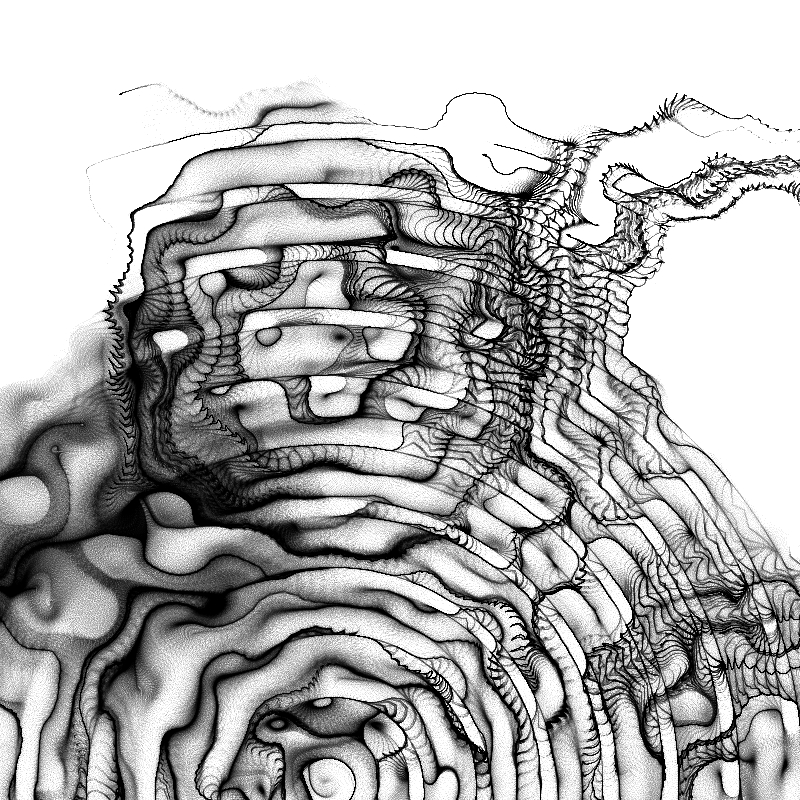
For the next one I've checked the Add Noise parameter. Gnarl with Noise is currently the only function plug-in that uses noise. It took me awhile to find something that showed how adding noise is different to adding a transform. If you duplicate the image and un-check Add Noise you'll see that the overall shape doesn't change much but the noise adds a nice texture.
20181013dDynamicalSystemsExample
::hVJwUin2dWVyutNMQ07Gw/DEqntiWjtbBv01LNFFouAtAFQgRakNR4iAJVq9ffHKKvlkG30T
iam3MzjzGbNsaHT86pTIEH3JAaUWS6i0k08Gy73pYSeNTQ+2OrDkWyH2ykdCg8qiIyv5NuN0
FJJkNAf9Gn/o3NC2OwYppkaD0wdWa0NMzdkV6frsgq5NpJXlmflPKRTnMAeI61sOHXroRvlV
f3ajuX1ER0dsaubHNFjiEcb0NUZvwx7YW70JSWXHXtOYOocghOLJuoIrcee+yirSiTWkXUkW
cdSSBRyWroJxlLXmuIjwUrxL7s08ypTa1G0rsB/IZb5eH5jYLXAYGAzJSXcfrMigBxsz/7sO
+WQER6q4KLvBoK90JhjhcphpstofUaFMdiu39YVCuCYGiB6AmDBeW8Kj7rFRe8HjZz+6xMbo
eMz4ZgdomUJ1IN+kh34N6g0x8SyVJHlFqclogNYCJF/i36K/1m5LBWaZSwHGwqF9DllyEvDq
5maMTZQDs35pcXVTPTU12rqDm6zDeT/xHRRflZYyQ2Tc7rvZV1nUMj4LauF+4oFRnhNmRzfo
9x3SzJtnKoVlStc1DFm5F6t+Byzp1aL6yf+kU6QT+BGFIArppS5ZKdH4te4cFTiNmOac5BJW
0UgmNmxCycwWXvBivvaNoADveod6xar1CtB7g9q/L2bYNcsEeJkd7Pd6V7t9yubYd2VBVRPr
hnT2LBFbi7sbYdACO95BvCh+NP03Jwp2T53XBDODM0OMQxf5dEyz/Zn9S48js8/+KErxVm3D
W68XkVd4WROO2qqB/aoQj6/ot+Oec/hy9iioFgGaaWeR51Xgq62WL4opfY2inHYYt5Scz6zj
DEw9DLTo5XELTervFneRgc19gxNOP6nPDrSxt3HW7cUSUtWK1qhetvbBzq9aiOF2T1Bdqyj+
LMBfque0rnpfcx7ZZ99DwhHpQKhnxhAkR4DouNkP7f6EHsJ7nwJMxa8gbjMOiYlaNuq2fj5q
GYLNJ4GEKN965znnlWOqpc+TLPrMbURyok8lLP6lTEuXC+cV4Z3BOPSBcX/IDO8ocWJ2E/HA
emO2sC==
}
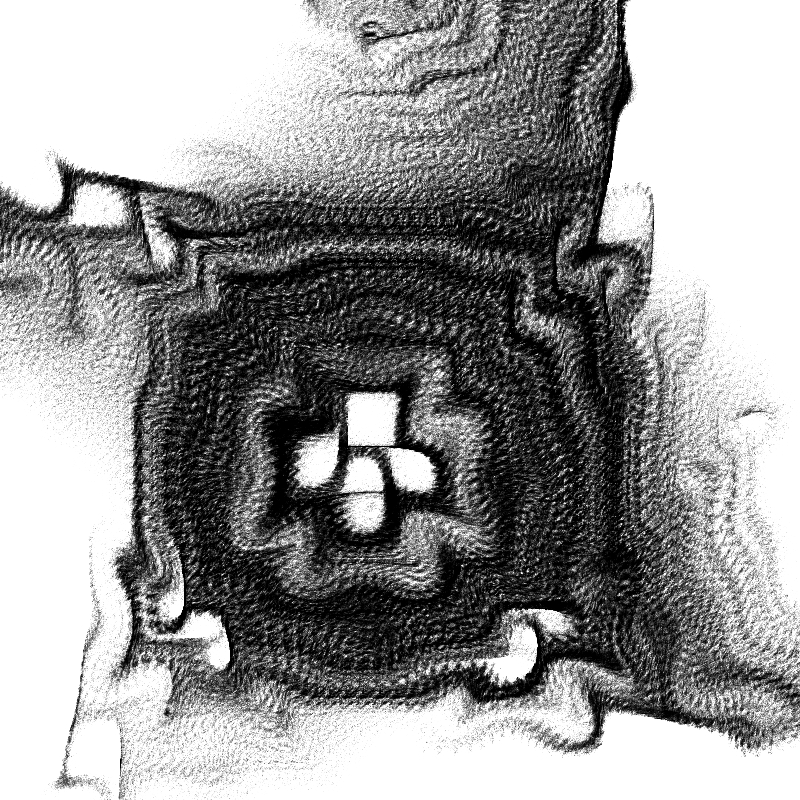
Finally, I left the noise but checked Dual Functions and chose Popcorn for the second function.
20181013eDynamicalSystemsExample
::PysfQin2dW1SvtNMM47BI/HE8OHXbn58YD6S362l1hB0MgNgBYoaTnIU9CSydJ/7HllTTSbX
z6OZZyPS+RKSqWLr2zEvb8ICxz9CgmUklvIPLfKQ+4OFTyrZCyN7ceQ6IXtlJNCg8myEyv5N
+N0FZZkNAf9Gf4YwNC2Ow6o5kaL0w9Oay1M7dkV6frcgq595ZXkP9iQUSGPqHcf0rZGPXroJ
XyqvbtV3paSIaDrm73RzxoIB/GdDV2J8cDz5GPSyMGuad0cQ5BLdSWa2bXMPfxyZllXg/Mrs
oIb5CiktWRzSLXuMfRBhpWjp6SkvtaL6RWvPkst8gTCRrlLAM7x6h0n21KTIYAs7C/Oxw3Ci
Eipirc8Ggq0jHFPGrjWmy1i+RpVw4R6O/TVJ4KgZJWwAMPC8k4Vm2VLSC4PEzm93FTcx7iJ2
ADc93HVSNSjPb5NBjeQ6QNJ7isDyi3azQBbwyRO+Fz6qQazClfHtML6DL40iu+rkysgDq52a
sSZRDc3FospqpjJqa7U1RT3Buot/4TosvxsMZs8Ju9dXvq6zKmV8VN3BfawkkTwmyoTfs9p3
SnSaPWQrKn64qHLsIIMY9jkPlWrdoL/5zSpvpN1ar6B+ED/BspGM8mKWTTlKQ8QKi/3fuiJx
mUPNt8BJO8+BoFDVwoMPs13Zh07rWDKwyr7bveq2atQbxu5g6/i9WWDHvSPHSz+THnpX2JNX
zMuVRVJvohnS2zBFbqNuNMDggzfZwrQo3Eg+BBOBfyNBYxZi+ujeK+rgjQe+P7sXDnfil/3p
QqGXfeP4ozfVWZwNkccMWVDhlSx+2/RbDDA4+El/VFRHAN08ipvtc2Zoqut1Bea+VTW8yA3v
EN9MVbQA33vchO9sYZybDt40zCkruHs+h5xw8Zc1KuNvfdcw0DSSq1SpW13r9dHYXtXTyxwe
uOojVewfxJ4j11he9E9DLiPpqvfAO+gFSJ8MOEgMCfM1vh8lwzo4gNZ/EOhJWjH8bkpJEnUr
xV3hMmragt0sobQo08ZznPvIvcQT58nXeRZxgisBJTXu8gXOS4eJ4zXxng758AFwd/DM4hHo
LKxm4/Q170tk
}
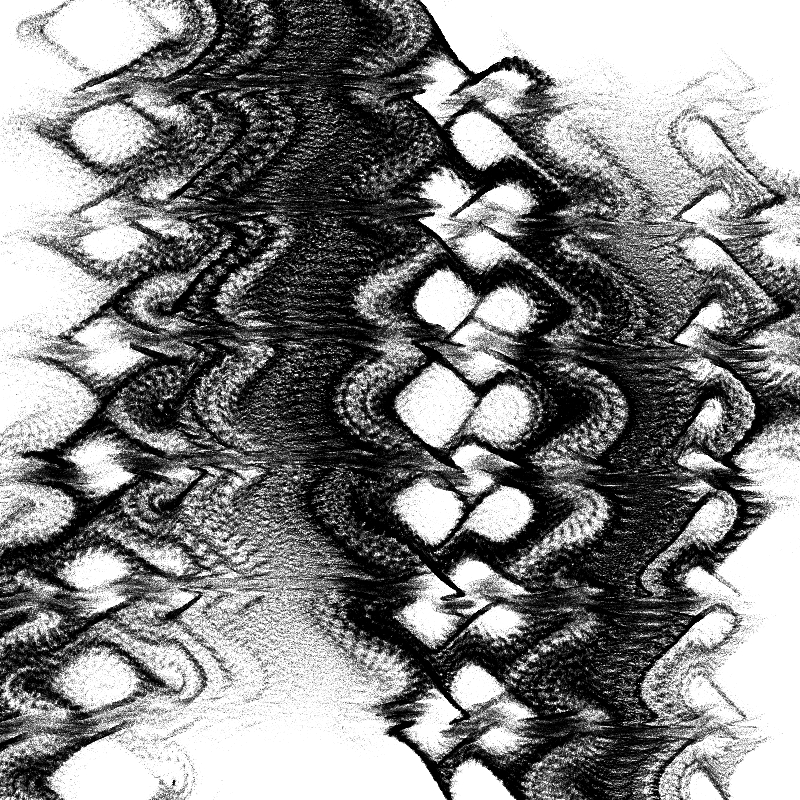
Here are some belated examples and a few tips...
The first example is a good starting point for exploration. Note that the Drawing Method on the Formula tab is set to One-pass Linear and that Repeat Gradient on the Outside tab is un-checked. The gradient is greyscale. You can try other types of gradients but the results will vary.
````
20181013aDynamicalSystemsExample#1 {
fractal:
title="20181013a Dynamical Systems Example #1" width=800 height=800
layers=1 credits="Mark Townsend;10/13/2018"
layer:
caption="Background" opacity=100 method=multipass
mapping:
center=0/0 magn=0.15
formula:
maxiter=100 filename="mt.ufm" entry="mt-pixel" p_inside=no
inside:
transfer=none
outside:
transfer=linear repeat=no filename="mt5.ucl"
entry="mt-dynamical-systems-r" p_sample_mode=Grid
p_sample_center=0/0 p_sample_width=20 p_h=0.1 p_max_iterations=50
p_resolution=500 p_circular_mask=no p_dual_functions=no
p_XFuncParam="mt.ulb:MT_VineFunction" p_XFuncParam.flavor=-1
p_XFuncParam.a=7 p_XFuncParam.b=2.0
p_YFuncParam="mt.ulb:MT_DynamicalFunction" p_add_noise=no
p_noise_amount=1 p_noise_scale=1 p_noise_texture.v_generic=100
p_noise_texture.v_coloring=100
p_noise_texture.v_gradientcoloring=100
p_noise_texture.p_texture="mt.ulb:MT_PerlinNoiseTexture"
p_noise_texture.p_texture.v_generic=100
p_noise_texture.p_texture.v_trapshape=101
p_noise_texture.p_texture.octaves=7
p_noise_texture.p_texture.persistence=0.5
f_noise_texture.p_texture.fn1=ident
p_noise_texture.p_texture.seed=1234567 p_add_transform=no
p_transform="common.ulb:UserTransform" p_transform.v_generic=100
p_transform.v_transform=100 p_transform.v_usertransform=100
p_seed=1234567
gradient:
comments="Use with Lighting coloring algorithm." smooth=yes index=0
color=16777215 index=399 color=0 index=399 color=0
opacity:
smooth=no index=0 opacity=255
}
````

For then next one I changed the Vine parameters and zoomed into one of the patterns. Because I'm zooming in I can decrease the Width parameter because I want to concentrate the calculation on the visible area. I copied Center from the Location tab and pasted it into the Center parameter of the coloring. For this one I've changed the Sample Mode to "Random". I've included an image of the Vine fractal formula in the same location so you can see the differences.
````
20181013bDynamicalSystemsExample#2 {
fractal:
title="20181013b Dynamical Systems Example #2" width=800 height=600
layers=1 credits="Mark Townsend;10/13/2018"
layer:
caption="Background" opacity=100 method=multipass
mapping:
center=-3.1333333335/-3.09999999985 magn=0.6
formula:
maxiter=100 filename="mt.ufm" entry="mt-pixel" p_inside=no
inside:
transfer=none
outside:
transfer=linear repeat=no filename="mt5.ucl"
entry="mt-dynamical-systems-r" p_sample_mode=Random
p_sample_center=-3.1333333335/-3.09999999985 p_sample_width=8
p_h=0.1 p_max_iterations=20 p_resolution=1000 p_circular_mask=no
p_dual_functions=no p_XFuncParam="mt.ulb:MT_VineFunction"
p_XFuncParam.flavor=0 p_XFuncParam.a=7 p_XFuncParam.b=2.0
p_YFuncParam="mt.ulb:MT_DynamicalFunction" p_add_noise=no
p_noise_amount=1 p_noise_scale=1 p_noise_texture.v_generic=100
p_noise_texture.v_coloring=100
p_noise_texture.v_gradientcoloring=100
p_noise_texture.p_texture="mt.ulb:MT_PerlinNoiseTexture"
p_noise_texture.p_texture.v_generic=100
p_noise_texture.p_texture.v_trapshape=101
p_noise_texture.p_texture.octaves=7
p_noise_texture.p_texture.persistence=0.5
f_noise_texture.p_texture.fn1=ident
p_noise_texture.p_texture.seed=1234567 p_add_transform=no
p_transform="common.ulb:UserTransform" p_transform.v_generic=100
p_transform.v_transform=100 p_transform.v_usertransform=100
p_seed=1234567
gradient:
comments="Use with Lighting coloring algorithm." smooth=yes index=0
color=16777215 index=0 color=16777215 index=259 color=0 index=399
color=0 index=399 color=0
opacity:
smooth=no index=0 opacity=255
}
````


Next I add a Transform. I tend to go straight for my "Trap Shape" transform plug-in because it allows me to load my texture plug-ins and it has a Strength parameter. Notice that I've added a new control point to the gradient and dragged it to the left to darken the image. This one takes a bit longer to appear. That's a combination of the higher Resolution and the fact that the transform is calculated for every iteration.
````
20181013cDynamicalSystemsExample#3 {
fractal:
title="20181013c Dynamical Systems Example #3" width=800 height=800
layers=1 credits="Mark Townsend;10/13/2018"
layer:
caption="Background" opacity=100 method=multipass
mapping:
center=-2.1607881435/3.1891277375 magn=0.50420168 angle=44.2834
formula:
maxiter=100 filename="mt.ufm" entry="mt-pixel" p_inside=no
inside:
transfer=none
outside:
transfer=linear repeat=no filename="mt5.ucl"
entry="mt-dynamical-systems-r" p_sample_mode=Grid
p_sample_center=0/0 p_sample_width=10 p_h=0.1 p_max_iterations=50
p_resolution=1000 p_circular_mask=no p_dual_functions=no
p_XFuncParam="mt.ulb:MT_VineFunction" p_XFuncParam.flavor=-1
p_XFuncParam.a=7 p_XFuncParam.b=2.0
p_YFuncParam="mt.ulb:MT_DynamicalFunction" p_add_noise=no
p_noise_amount=1 p_noise_scale=1 p_noise_texture.v_generic=100
p_noise_texture.v_coloring=100
p_noise_texture.v_gradientcoloring=100
p_noise_texture.p_texture="mt.ulb:MT_PerlinNoiseTexture"
p_noise_texture.p_texture.v_generic=100
p_noise_texture.p_texture.v_trapshape=101
p_noise_texture.p_texture.octaves=7
p_noise_texture.p_texture.persistence=0.5
f_noise_texture.p_texture.fn1=ident
p_noise_texture.p_texture.seed=1234567 p_add_transform=yes
p_transform="mt.ulb:MT_TrapShapeTransform" p_transform.v_generic=100
p_transform.v_transform=100 p_transform.v_usertransform=100
p_transform.mode="Return Value" p_transform.strength=0.03
p_transform.p_trapshape="reb.ulb:REB_TrapShapeLissajous"
p_transform.p_trapshape.v_generic=100
p_transform.p_trapshape.v_trapshape=101
p_transform.p_trapshape.v_Lissajous=101
p_transform.p_trapshape.a=0.2 p_transform.p_trapshape.b=1
p_transform.p_trapshape.c=1 p_transform.p_trapshape.scale=1
p_transform.p_trapshape.partype="cabs(z)" p_seed=1234567
gradient:
comments="Use with Lighting coloring algorithm." smooth=yes index=0
color=16777215 index=146 color=0 index=399 color=0 index=399 color=0
opacity:
smooth=no index=0 opacity=255
}
````

For the next one I've checked the Add Noise parameter. Gnarl with Noise is currently the only function plug-in that uses noise. It took me awhile to find something that showed how adding noise is different to adding a transform. If you duplicate the image and un-check Add Noise you'll see that the overall shape doesn't change much but the noise adds a nice texture.
````
20181013dDynamicalSystemsExample#4 {
::hVJwUin2dWVyutNMQ07Gw/DEqntiWjtbBv01LNFFouAtAFQgRakNR4iAJVq9ffHKKvlkG30T
iam3MzjzGbNsaHT86pTIEH3JAaUWS6i0k08Gy73pYSeNTQ+2OrDkWyH2ykdCg8qiIyv5NuN0
FJJkNAf9Gn/o3NC2OwYppkaD0wdWa0NMzdkV6frsgq5NpJXlmflPKRTnMAeI61sOHXroRvlV
f3ajuX1ER0dsaubHNFjiEcb0NUZvwx7YW70JSWXHXtOYOocghOLJuoIrcee+yirSiTWkXUkW
cdSSBRyWroJxlLXmuIjwUrxL7s08ypTa1G0rsB/IZb5eH5jYLXAYGAzJSXcfrMigBxsz/7sO
+WQER6q4KLvBoK90JhjhcphpstofUaFMdiu39YVCuCYGiB6AmDBeW8Kj7rFRe8HjZz+6xMbo
eMz4ZgdomUJ1IN+kh34N6g0x8SyVJHlFqclogNYCJF/i36K/1m5LBWaZSwHGwqF9DllyEvDq
5maMTZQDs35pcXVTPTU12rqDm6zDeT/xHRRflZYyQ2Tc7rvZV1nUMj4LauF+4oFRnhNmRzfo
9x3SzJtnKoVlStc1DFm5F6t+Byzp1aL6yf+kU6QT+BGFIArppS5ZKdH4te4cFTiNmOac5BJW
0UgmNmxCycwWXvBivvaNoADveod6xar1CtB7g9q/L2bYNcsEeJkd7Pd6V7t9yubYd2VBVRPr
hnT2LBFbi7sbYdACO95BvCh+NP03Jwp2T53XBDODM0OMQxf5dEyz/Zn9S48js8/+KErxVm3D
W68XkVd4WROO2qqB/aoQj6/ot+Oec/hy9iioFgGaaWeR51Xgq62WL4opfY2inHYYt5Scz6zj
DEw9DLTo5XELTervFneRgc19gxNOP6nPDrSxt3HW7cUSUtWK1qhetvbBzq9aiOF2T1Bdqyj+
LMBfque0rnpfcx7ZZ99DwhHpQKhnxhAkR4DouNkP7f6EHsJ7nwJMxa8gbjMOiYlaNuq2fj5q
GYLNJ4GEKN965znnlWOqpc+TLPrMbURyok8lLP6lTEuXC+cV4Z3BOPSBcX/IDO8ocWJ2E/HA
emO2sC==
}
````

Finally, I left the noise but checked Dual Functions and chose Popcorn for the second function.
````
20181013eDynamicalSystemsExample#5 {
::PysfQin2dW1SvtNMM47BI/HE8OHXbn58YD6S362l1hB0MgNgBYoaTnIU9CSydJ/7HllTTSbX
z6OZZyPS+RKSqWLr2zEvb8ICxz9CgmUklvIPLfKQ+4OFTyrZCyN7ceQ6IXtlJNCg8myEyv5N
+N0FZZkNAf9Gf4YwNC2Ow6o5kaL0w9Oay1M7dkV6frcgq595ZXkP9iQUSGPqHcf0rZGPXroJ
XyqvbtV3paSIaDrm73RzxoIB/GdDV2J8cDz5GPSyMGuad0cQ5BLdSWa2bXMPfxyZllXg/Mrs
oIb5CiktWRzSLXuMfRBhpWjp6SkvtaL6RWvPkst8gTCRrlLAM7x6h0n21KTIYAs7C/Oxw3Ci
Eipirc8Ggq0jHFPGrjWmy1i+RpVw4R6O/TVJ4KgZJWwAMPC8k4Vm2VLSC4PEzm93FTcx7iJ2
ADc93HVSNSjPb5NBjeQ6QNJ7isDyi3azQBbwyRO+Fz6qQazClfHtML6DL40iu+rkysgDq52a
sSZRDc3FospqpjJqa7U1RT3Buot/4TosvxsMZs8Ju9dXvq6zKmV8VN3BfawkkTwmyoTfs9p3
SnSaPWQrKn64qHLsIIMY9jkPlWrdoL/5zSpvpN1ar6B+ED/BspGM8mKWTTlKQ8QKi/3fuiJx
mUPNt8BJO8+BoFDVwoMPs13Zh07rWDKwyr7bveq2atQbxu5g6/i9WWDHvSPHSz+THnpX2JNX
zMuVRVJvohnS2zBFbqNuNMDggzfZwrQo3Eg+BBOBfyNBYxZi+ujeK+rgjQe+P7sXDnfil/3p
QqGXfeP4ozfVWZwNkccMWVDhlSx+2/RbDDA4+El/VFRHAN08ipvtc2Zoqut1Bea+VTW8yA3v
EN9MVbQA33vchO9sYZybDt40zCkruHs+h5xw8Zc1KuNvfdcw0DSSq1SpW13r9dHYXtXTyxwe
uOojVewfxJ4j11he9E9DLiPpqvfAO+gFSJ8MOEgMCfM1vh8lwzo4gNZ/EOhJWjH8bkpJEnUr
xV3hMmragt0sobQo08ZznPvIvcQT58nXeRZxgisBJTXu8gXOS4eJ4zXxng758AFwd/DM4hHo
LKxm4/Q170tk
}
````







